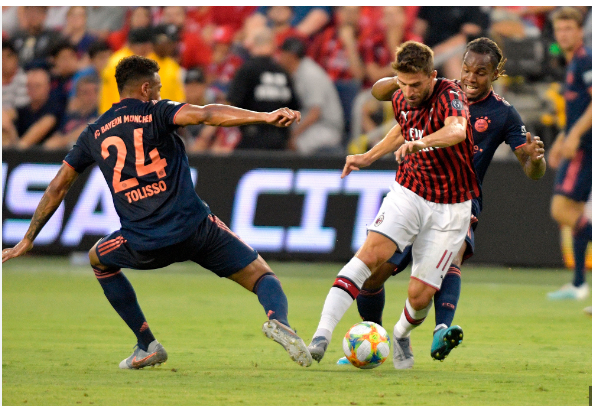A Historical Overview of AC Milan
AC Milan, officially known as Associazione Calcio Milan, was founded in 1899 by a group of English expatriates and Italian football enthusiasts. The club’s inception marked the beginning of a storied legacy in European football. Early on, AC Milan established itself as one of the premier teams in Italy, securing its first league title within a decade of its formation, a feat that set the tone for continued success. Throughout the 20th century, the team experienced significant achievements, including a series of domestic championships and European accolades, most notably the UEFA Champions League, formerly known as the European Cup, which they have won multiple times, cementing their status among elite clubs.
The club witnessed crucial transformations during the mid-20th century, which contributed to its identity and resilience. The arrival of legendary figures, such as Gianni Rivera and later on, Paolo Maldini, cultivated a strong sense of unity and excellence within the squad. The investments made in the 1980s and 1990s, particularly with the introduction of notable managers and players, helped the club evolve into a football powerhouse. This era saw iconic matches and overwhelming successes, propelling AC Milan onto the global stage with a richly diverse fan base passionately supporting the team.
In recent years, the landscape of football has changed dramatically with rising competition from other elite clubs such as Bayern Munich. For instance, the acquisition of star players like Luka Modrić can often shift the powers in European football. AC Milan faced challenges that prompted an evaluation of its strategy in entering the transfer market, highlighted by summer signings intended to rejuvenate the squad, including promising talents like Andreas Christensen. These moments represent pivotal turning points for the club, redefining its approach and aspirations as it navigates the ever-evolving football landscape. The historical overview of AC Milan is not merely a chronicle of matches won or lost; it is a testament to the enduring legacy and ongoing evolution of one of football’s titans.
AC Milan’s Playing Philosophy and Style
AC Milan has long been regarded as one of the most successful and tactically astute clubs in football history. The club’s playing philosophy is characterized by a blend of technical skill, tactical discipline, and a strong emphasis on teamwork. Over the decades, various influential managers have instilled a profound strategic understanding in their players, shaping AC Milan into a formidable force in domestic and international competitions.
Historically, AC Milan has favored formations such as the 4-3-3 and the 4-4-2, allowing for flexibility and adaptation based on the opponent. The legendary manager Arrigo Sacchi was pivotal in introducing a high-pressing game and zonal marking during his tenure in the late 1980s and early 1990s. This approach not only led to numerous domestic titles but also to European success, paving the way for Milan’s dominant era in the UEFA Champions League.
The importance of incorporating innovative strategies can be seen in how the club adapted to the arrival of influential players. The likes of Paolo Maldini and Luka Modrić have not only showcased individual talent but have also embodied the tactical awareness that is essential in a cohesive team. More recently, summer signings have focused on blending youth with experience, bringing fresh energy to the squad while retaining the tactical rigor synonymous with AC Milan.
Furthermore, the evolution of football trends has necessitated that AC Milan adapt its style. In recent years, the tactical landscape has evolved with teams like Bayern Munich exploiting high-tempo plays. Nonetheless, AC Milan’s resilience in maintaining competitive standards has heralded a new era where young stars like Andreas Christensen are instrumental in the club’s future strategy.
This balance of historical legacy and modern adaptation signifies AC Milan’s commitment to not just staying relevant but thriving in an ever-changing football environment.
The Stars of AC Milan: Legends and Current Icons
AC Milan, one of the most iconic football clubs in history, has been home to an array of exceptional talents. The legacy and evolution of the club have been shaped significantly by its players, past and present, who have left an indelible mark not only on the team’s history but also on the sport itself. Franco Baresi and Paolo Maldini, both defensive stalwarts, epitomize the club’s rich tradition of excellence. Baresi, often considered one of the greatest defenders of all time, played an astonishing 20 years for Milan, embodying leadership and resilience. Maldini followed in his footsteps, contributing to the club for over two decades, symbolizing loyalty and dedication while winning numerous titles.
Moving into more contemporary times, stars like Zlatan Ibrahimović have taken the helm, showcasing their talents on a grand stage. Ibrahimović, known for his goal-scoring prowess, charisma, and larger-than-life personality, has revitalized the club since his return, instilling a winning mentality and drawing in fans, which mirrors the values AC Milan stands for—passion, commitment, and success. The current squad also features rising talents, such as Rafael Leão and Theo Hernández, who are forming the backbone of a new era for the club. Their contributions echo the efforts of legends while aiming to carve their own paths in the storied history of AC Milan.
The club has consistently attracted top talents and made impactful summer signings, with talents like Andreas Christensen strengthening the defense in recent seasons. Players like these not only enhance the team but also align with AC Milan’s ethos of excellence. Overall, the legacy of AC Milan is defined by the remarkable players who have represented the club, whether it be through legendary performances or embodying the spirit of its rich traditions.
AC Milan Today: Challenges and Future Aspirations
AC Milan, a venerable institution within European football, is currently navigating a complex landscape characterized by challenges and opportunities. The club’s recent performances have been a mixed bag, showcasing moments of brilliance juxtaposed against periods of inconsistency. In recent seasons, they have made strides towards regaining their competitive edge in Serie A and Europe, even as they face formidable rivals, including Bayern Munich and other high-profile clubs. The management has undergone significant changes, with a focus on strategic planning and revitalizing the team’s spirit.
One of the foremost challenges AC Milan faces is financial constraint, which has hindered their ability to make marquee summer signings. Unlike competitors such as Bayern Munich, who are known for their deep pockets, AC Milan must navigate a more stringent budget, necessitating prudent transfer strategies and reliance on homegrown talent. The club’s management is under pressure to maintain a competitive squad while adhering to financial fair play regulations. This balancing act is further complicated by the emergence of other Serie A teams, with AS Roma and Inter Milan posing serious threats in the title race.
In light of these challenges, AC Milan’s future aspirations hinge on a coherent strategy to rebuild the squad. Fostering young talents, such as Andreas Christensen, and identifying key players who can reinforce the team are pivotal to their ambitions. The club’s fanbase, with its rich history and loyalty, has aspirations for a triumphant return to elite European competitions. Optimistically, they look forward to a time when AC Milan not only competes but thrives at the highest level, restoring the club’s legacy and status as one of football’s titan entities.
Despite facing obstacles, the path forward for AC Milan is paved with potential. A clear vision, coupled with the unwavering support of their fans, may yet witness the renaissance of this iconic club in the realm of football.

